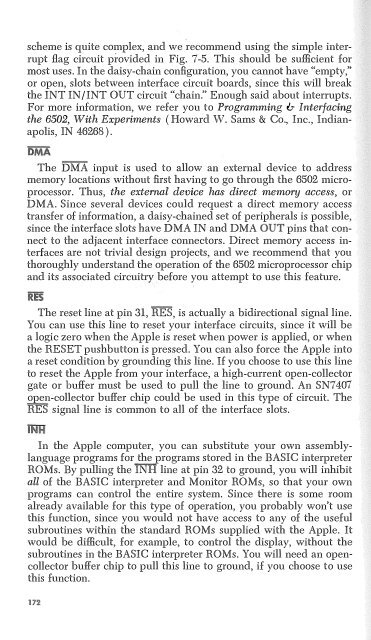Create successful ePaper yourself
Turn your PDF publications into a flip-book with our unique Google optimized e-Paper software.
scheme is quite complex, and we recommend using the simple interrupt<br />
flag circuit provided in Fig. 7 -5. This should be sufficient for<br />
most uses. In the daisy-chain configuration, you cannot have "empty,"<br />
or open, slots between interface circuit boards, since this will break<br />
the INT IN /INT OUT circuit "chain." Enough said about interrupts.<br />
For more information, we refer you to Programming & Interfacing<br />
the 6502, With Experiments (Howard W. Sams & Co., Inc., Indianapolis,<br />
IN 46268).<br />
DMA<br />
The DMA input is used to allow an external device to address<br />
memory locations without first having to go through the 6502 microprocessor.<br />
Thus, the external device has direct memory access, or<br />
DMA. Since several devices could request a direct memory access<br />
transfer of information, a daisy-chained set of peripherals is possible,<br />
since the interface slots have DMA IN and DMA OUT pins that connect<br />
to the adjacent interface connectors. Direct memory access interfaces<br />
are not trivial design projects, and we recommend that you<br />
thoroughly understand the operation of the 6502 microprocessor chip<br />
and its associated circuitry before you attempt to use this feature.<br />
R.!:S<br />
The reset line at pin 31, RES, is actually a bidirectional signal line.<br />
You can use this line to reset your interface circuits, since it will be<br />
a logic zero when the Apple is reset when power is applied, or when<br />
the RESET pushbutton is pressed. You can also force the Apple into<br />
a reset condition by grounding this line. If you choose to use this line<br />
to reset the Apple from your interface, a high-current open-collector<br />
gate or buffer must be used to pull the line to ground. An SN7407<br />
open-collector buffer chip could be used in this type of circuit. The<br />
RES signal line is common to all of the interface slots.<br />
!NH<br />
In the Apple computer, you can substitute your own assemblylanguage<br />
programs for the programs stored in the BASIC interpreter<br />
ROMs. By pulling the INH line at pin 32 to ground, you will inhibit<br />
all of the BASIC interpreter and Monitor ROMs, so that your own<br />
programs can control the entire system. Since there is some room<br />
already available for this type of operation, you probably won't use<br />
this function, since you would not have access to any of the useful<br />
subroutines within the standard ROMs supplied with the Apple. It<br />
would be difficult, for example, to control the display, without the<br />
subroutines in the BASIC interpreter ROMs. You will need an opencollector<br />
buffer chip to pull this line to ground, if you choose to use<br />
this function.

















